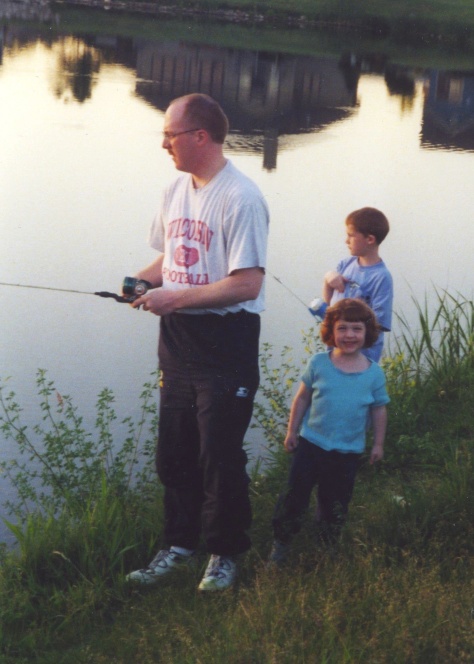By Joseph Hanneman
Racine Journal Times
It was Christmas 1986, and little Sarah Mazzie was making out her wish list for Santa Claus. At the top of the list wasn’t a Barbie doll, a Cabbage Patch Kid or a doll house.
At the top of Sarah’s list was written: “good health.”
“That amazed me, a child that age asking for good health,” said Sarah’s mother, Mary. “It was in that little scrawl handwriting, ‘Good health.’ ”
The 6-year-old Racine girl had her priorities straight. In the 20 months since she was diagnosed with acute lymphocytic leukemia, Sarah learned what it was like to be sick, to endure painful treatments and lose her hair. “Good health” has been on her Christmas list ever since.

Bruce Camitta doesn’t look much like Santa Claus. He doesn’t have the Santa-like spare tire, and his thinning crop of hair doesn’t resemble St. Nick’s white mane.
But for Sarah, Camitta might as well have been Santa Claus.
The professor of pediatrics at the Medical College of Wisconsin in Wauwatosa had developed an experimental leukemia treatment that would save Sarah’s life.
Preventing recurrence
Camitta’s treatment used high doses of chemotherapy, followed by an extended period of lower doses, administered after patients had gone into remission. Patients often respond well to initial treatment, but Camitta’s goal was to prevent recurrence of the cancer.
Sarah was his 27th patient in the trial at Children’s Hospital of Wisconsin in suburban Milwaukee, and one of the 80-plus percent for whom the treatment has worked. She has been cancer-free ever since.
“He says I’m a pioneer girl,” said Sarah, now a pretty 11-year-old sixth-grader at Mitchell Middle School. She’s proud that she helped break medical ground and beat the cancer that could have stolen her young life.
“I don’t think about it,” she said of the leukemia. “It’s not hard, I’m just lucky they had medicine.”
Wearing a red shirt, black jeans and deck shoes, Sarah sits in a director’s chair at her family’s home on Newman Road in Mount Pleasant. Her long, black hair, dark eyes and striking smile tell no tale of cancer.

She twists her hair with her fingers, fidgets in the chair and toys with the family cat. This isn’t Sarah Mazzie cancer survivor, it’s Sarah, regular 11-year-old.
“I like playing sports,” she said. “I play baseball, soccer and I go horseback riding.” She also likes tennis and swimming.
Those words seem music to the ears of Gary and Mary Mazzie, who just seven years ago faced what all parents dread — the loss of a child to a deadly disease like cancer.
In January 1985, Sarah’s parents first noticed changes in their daughter, including a persistent low-grade fever, and pains in her arms and legs. Doctors at first thought it was a virus.
“She canceled her own birthday party because she didn’t feel well,” Mary said. “I knew something was wrong.”
Things didn’t reach crisis level until the family was on vacation in South Carolina that spring. Sarah was listless, and all she did at the beach was lie on blanket. She couldn’t even walk.
‘The bottom falls out’
The Mazzies rushed back to Racine and, after Sarah had a blood test, were told to get her to Children’s Hospital. They were told to go to the oncology department.
“At that point,” Mary said, “the bottom falls out.”
Mary remembers the day the doctor called to confirm the diagnosis of leukemia. She walked out into the back yard and screamed. After walking around a bit, she called her husband at work.
“She couldn’t even talk,” Gary recalled.

Inside Sarah’s body, the cancer was causing white blood cells called lymphocytes to grow erratically. Billions of faulty cells were crowding out normal white cells in her bone marrow.
“The doctors tried to tell us there was much hope with this type of cancer,” Mary said. ‘At that point, it’s very difficult to believe that.”
Gary said there was “some doubt in my mind” about trying an experimental treatment, but the couple decided to put Sarah in the trial group being gathered by Dr. Camitta.
Sarah would he treated with standard chemotherapy until the disease was in remission, then undergo six months of intensive chemotherapy and two years of oral anti-leukemia drugs.
Intensive treatment
Camitta said the goal is to keep drug levels high over long periods to reduce the number of leukemic cells in the system. Treating a child who is in remission with intensive chemotherapy was considered a somewhat “rogue” idea in the medical community at the time, he said.
Mary stayed in the hospital with Sarah each night, and Gary visited after work. Sarah was hospitalized for 21 days, and after about two weeks of chemotherapy, her cancer was in remission.
Sarah then came back to the hospital every two weeks for an infusion of methotrexate and 6-mercaptopurine, the drug combination Camitta had chosen for the experiment. Every other week, she went to the clinic for a checkup.
Doctors periodically had to insert a needle into Sarah’s spine to check for leukemic cells, and to inject chemotherapy into the spinal fluid. They also took marrow samples from her pelvis by inserting a sharp lance into the bone.
Sarah said the bone marrow biopsies were scary.
“When they were taking the blood (marrow), it hurt in my leg,” she said.
Sarah would lie on the examining table, hugging her favorite stuffed dog, Amos. She imagined that she was somewhere else, somewhere with no pain, doing something fun.
“One time I thought about the Fourth of July parade. Another time I thought about being at the beach,” she said.
Making something positive
Camitta said he was impressed that such a young child could remain so calm during treatments and tests. “She was super,” he said.
The treatments during those first six months made Sarah sick. The drugs dropped her count of infection-fighting white blood cells. She got headaches, and mouth sores. And her hair fell out.
To help make something positive out of a bad situation, Sarah took the hair that had fallen out off of her pillow each morning, and strung it out on the bushes outside. She wanted the birds to use it to build their springtime nests.
Although she was “kind of scared” about her hair falling out, Sarah adjusted. Most of her friends knew why she was losing her hair.
“When I was in kindergarten, someone thought I was a boy,” she said. “I knew it was going to grow back. I wore a lot of hats.”
Sarah’s parent said she handled the treatments well. She didn’t cry, or fight with the doctors. Her only response was to become silent and withdrawn on the way to the hospital. Occasionally she shed a few quiet tears.
Drug treatments continue
Once the first six months of drug treatments stopped, Sarah went home from the hospital. She began taking pills every day, and her mother gave her a shot every Wednesday.
Getting the pills down took some creativity on the part of her parents. The pills were mashed in food, coated with sugar and even mixed with syrup and shot down her throat with a syringe.
“They were just giving me so many medicines, and they all tasted bad,” Sarah said. “There was one l wouldn’t take. They put it in my food, tried to trick me. But I’d always find it.”

The Mazzies religiously followed doctors’ orders in giving Sarah the medicine. The pills continued until Oct. 2, 1987.
Ordeal is over
Then it was over. Or was it? Mary kept quizzing doctors to see if any other children in the trial had a relapse of cancer. They told her not to worry.
Of the 73 children who underwent the treatment in the first two trials, more than 80 percent have remained cancer-free over long periods, Camitta said.
“That’s as good as anything else available, and we’re only using two drugs,” said Camitta, who has a giant teddy bear perched on a file cabinet outside his office. But many more children will have to be tested on the trial nationally to confirm the results, he said.
Camitta won three ardent believers on Newman Road in Mount Pleasant.
Gary said the family is stronger for the ordeal, and he realizes just how fragile life is. Whenever he has a bad day at work, he just looks at a picture of Sarah from back then, and is reminded of what is most important to him.
As for Sarah, she’s gotten on with her life, and will turn 12 in February. Asked if she has any advice for other children with cancer, she doesn’t hesitate in her response.
“I’d tell them you’d probably get better. If they cured me, they should probably be able to cure kids now.”
EPILOGUE: Sarah B. Mazzie graduated from the University of Wisconsin in 2002 and earned her Juris Doctor degree from the DePaul University College of Law in 2006. She was a partner in her own law firm and has worked for Immigration and Customs Enforcement in the U.S. Department of Homeland Security. Now 40, she is a U.S. immigration judge in Minneapolis. Her parents Iive in Racine.
Top photo: Sarah Mazzie in her classroom at Mitchell Middle School in Racine. — Journal Times Photo by Mark Hertzberg.



















































